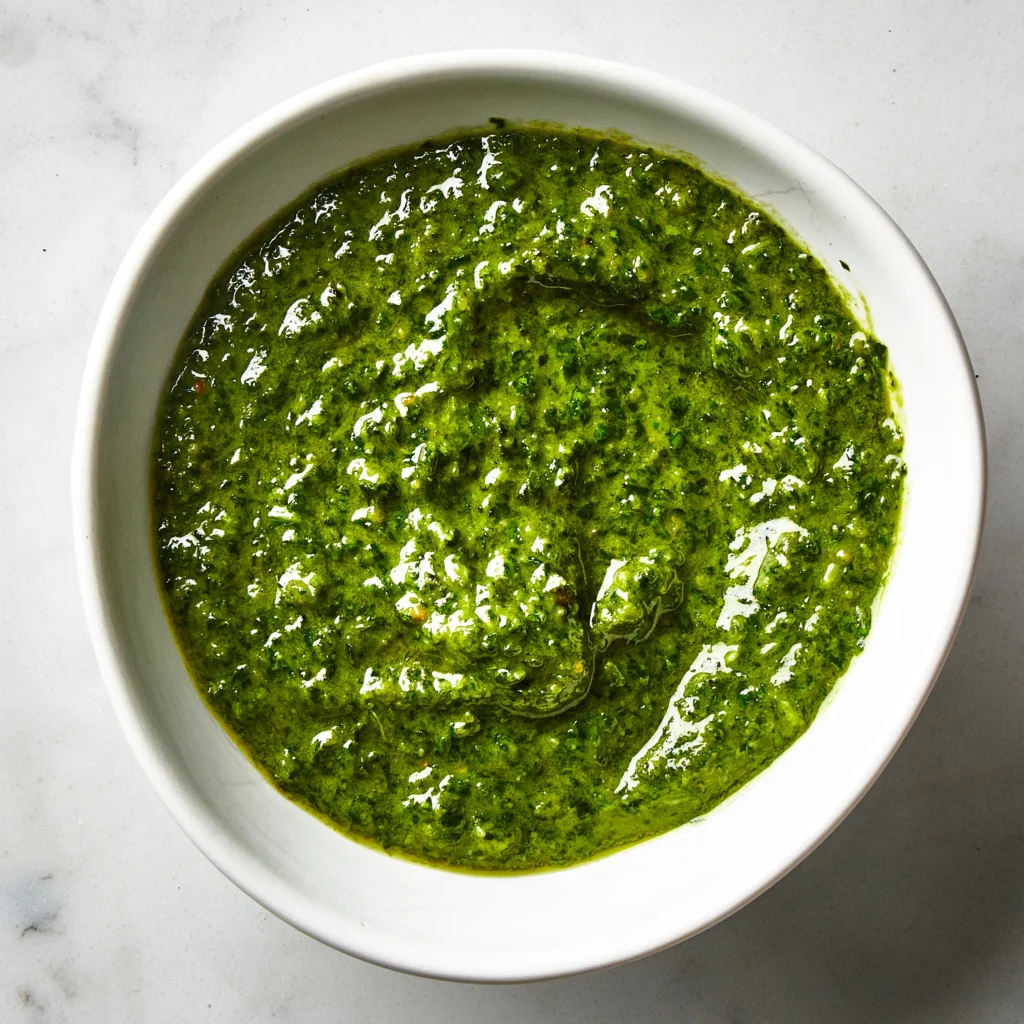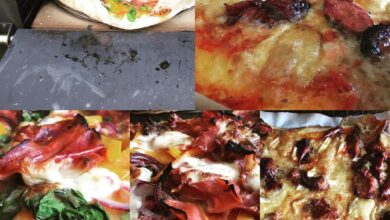
Pesto Recipe Introduction:
Pesto Recipe is a delicious and versatile Italian sauce that originated in the region of Liguria. Traditionally, it is made with fresh basil leaves, pine nuts, garlic, Parmesan cheese, and olive oil. Pesto has gained popularity worldwide for its vibrant flavors and ability to enhance a wide range of dishes.
This green sauce offers a perfect balance of aromatic herbs, rich nuts, and creamy cheese, creating a delightful explosion of flavors. It can be used as a sauce for pasta, a spread for sandwiches and bruschetta, a dip for vegetables, or even a marinade for grilled meats and seafood.
The beauty of pesto lies in its simplicity and ease of preparation. With just a handful of fresh ingredients, you can create a batch of pesto that will elevate your meals to a whole new level. So let’s dive into a classic pesto recipe that will surely impress your family and friends.
Ingredients:
2 cups fresh basil leaves, packed
1/2 cup pine nuts (you can also use walnuts or almonds)
3 cloves of garlic
1/2 cup grated Parmesan cheese
1/2 cup extra virgin olive oil
Salt and pepper to taste
Instructions:
Start by toasting the pine nuts (or other nuts) in a dry skillet over medium heat. Stir them frequently until they turn lightly golden and release their aroma. This should take about 3-4 minutes. Be careful not to burn them.
In a food processor or blender, combine the toasted nuts, basil leaves, garlic cloves, and grated Parmesan cheese. Pulse the ingredients a few times until they are roughly chopped and well combined.
While the food processor is running, slowly pour in the olive oil in a steady stream. This will help emulsify the sauce and create a smooth consistency. Continue blending until all the ingredients are fully incorporated and the pesto has a creamy texture.
Taste the pesto and season with salt and pepper according to your preference. Keep in mind that the Parmesan cheese is already salty, so adjust the seasoning accordingly.
Transfer the pesto to a jar or airtight container and store it in the refrigerator. It will stay fresh for up to one week. You can also freeze it in ice cube trays or small containers for longer storage.
Now you have a delightful batch of homemade pesto ready to elevate your culinary creations. Enjoy it tossed with pasta, spread on bread, or used as a flavor-packed condiment. Get creative and experiment with different variations by adding sun-dried tomatoes, spinach, or even substituting the nuts for a unique twist. The possibilities are endless!
Pesto Recipe Overview:
Pesto is a versatile Italian sauce made with fresh basil leaves, pine nuts (or other nuts), garlic, Parmesan cheese, and olive oil. It offers a vibrant and flavorful addition to various dishes. Here’s an overview of the pesto recipe:
Ingredients:
2 cups fresh basil leaves
1/2 cup pine nuts (or walnuts/almonds)
3 cloves of garlic
1/2 cup grated Parmesan cheese
1/2 cup extra virgin olive oil
Salt and pepper to taste
Instructions:
Toast the pine nuts in a dry skillet until golden and aromatic.
Combine the toasted nuts, basil leaves, garlic, and Parmesan cheese in a food processor or blender.
Pulse the ingredients until roughly chopped and well combined.
While the processor is running, gradually pour in the olive oil to create a smooth consistency.
Season with salt and pepper to taste.
Transfer the pesto to a jar or container and store it in the refrigerator for up to one week, or freeze it for longer storage.
Pesto can be used as a sauce for pasta, a spread for sandwiches and bruschetta, a dip for vegetables, or a marinade for grilled meats and seafood. Feel free to customize your pesto by adding variations like sun-dried tomatoes or spinach, or by using different types of nuts. Let your creativity shine and enjoy the vibrant flavors of homemade pesto!

Pesto Recipe Ingredients:
Certainly! Here are the ingredients for a classic pesto recipe:
2 cups fresh basil leaves, packed
1/2 cup pine nuts (alternatively, you can use walnuts or almonds)
3 cloves of garlic
1/2 cup grated Parmesan cheese
1/2 cup extra virgin olive oil
Salt and pepper to taste
These ingredients will come together to create a delicious and aromatic pesto sauce.
Pesto Recipe Instructions:
Certainly! Here are the instructions for making a classic pesto sauce:
Start by toasting the pine nuts (or other nuts) in a dry skillet over medium heat. Stir them frequently until they turn lightly golden and release their aroma. This should take about 3-4 minutes. Be careful not to burn them
In a food processor or blender, combine the toasted nuts, basil leaves, garlic cloves, and grated Parmesan cheese. Pulse the ingredients a few times until they are roughly chopped and well combined.
While the food processor is running, slowly pour in the olive oil in a steady stream. This will help emulsify the sauce and create a smooth consistency. Continue blending until all the ingredients are fully incorporated and the pesto has a creamy texture.
Taste the pesto and season with salt and pepper according to your preference. Keep in mind that the Parmesan cheese is already salty, so adjust the seasoning accordingly.
Transfer the pesto to a jar or airtight container and store it in the refrigerator. It will stay fresh for up to one week. You can also freeze it in ice cube trays or small containers for longer storage.
Now you have a delightful batch of homemade pesto ready to elevate your culinary creations. Enjoy it tossed with pasta, spread on bread, or used as a flavor-packed condiment. Get creative and experiment with different variations by adding sun-dried tomatoes, spinach, or even substituting the nuts for a unique twist. The possibilities are endless!
Pesto Recipe Variations:
Absolutely! Pesto is a versatile sauce that can be customized to suit your taste preferences. Here are a few variations you can try:
Sun-Dried Tomato Pesto: Add about 1/2 cup of sun-dried tomatoes (either packed in oil or rehydrated) to the classic pesto recipe. This will give it a rich, tangy flavor and a vibrant red color.
Spinach Pesto: Replace half of the basil leaves with fresh spinach leaves. This variation adds an extra dose of green goodness and a slightly milder flavor.
Nut Variations: Instead of pine nuts, try using walnuts, almonds, pistachios, or even a combination of different nuts. Each nut will impart its unique flavor and texture to the pesto.
Herb Pesto: Experiment with different herbs alongside or in place of basil. You can use cilantro, parsley, arugula, or a combination of herbs to create a distinct flavor profile.
Vegan Pesto: To make a vegan version, omit the Parmesan cheese or substitute it with nutritional yeast for a cheesy flavor. You can also add a splash of lemon juice to brighten the flavors.
Spicy Pesto: Add a kick of heat by including a chopped chili pepper or a sprinkle of red pepper flakes. Adjust the amount according to your desired level of spiciness.
Feel free to get creative and combine multiple variations to suit your preferences. Pesto is a versatile sauce, and these variations can add exciting twists to your dishes. Enjoy experimenting and discovering new flavors!
Pesto Recipe Presentation and Serving Suggestions:
Certainly! Here are some presentation and serving suggestions for your delicious pesto:
Pasta Sauce: Toss cooked pasta with the pesto sauce until well coated. You can use traditional pasta like spaghetti or try it with other shapes like penne, fusilli, or farfalle. Garnish with some freshly grated Parmesan cheese and a few basil leaves for a beautiful presentation.
Bruschetta: Spread pesto on slices of toasted baguette or Italian bread. Top it with fresh tomatoes, mozzarella cheese, and a drizzle of balsamic glaze for a delightful appetizer.
Sandwich Spread: Use pesto as a flavorful spread for sandwiches. It works well with grilled vegetables, roasted chicken, turkey, or even as a dressing for a Caprese sandwich.
Salad Dressing: Thin out the pesto sauce with a little extra olive oil and a splash of lemon juice. Drizzle it over a fresh green salad, tomato salad, or even a pasta salad for a burst of flavor.
Dip or Spread: Serve pesto as a dip for fresh vegetables like cherry tomatoes, cucumber slices, carrot sticks, or bell pepper strips. It also pairs well with breadsticks, pita chips, or crackers.
Grilled Meats and Seafood: Use pesto as a marinade or sauce for grilled chicken, steak, fish, or shrimp. The flavors of the pesto will enhance the natural flavors of the protein.
Garnish: Use a small dollop of pesto as a garnish on soups, such as tomato soup or minestrone, to add a burst of flavor and a vibrant green touch.
Remember to store any unused pesto in an airtight container in the refrigerator or freezer for future use.
These presentation and serving suggestions will help you showcase the vibrant flavors of pesto in various dishes. Feel free to get creative and explore new ways to enjoy this versatile sauce. Bon appétit!
Pesto Recipe Nutritional Information:
Here is an approximate nutritional information per serving for a classic pesto recipe (based on a standard serving size of 2 tablespoons):
Calories: 120-140 calories
Fat: 12-14 grams
Saturated Fat: 2-3 grams
Carbohydrates: 1-2 grams
Protein: 2-3 grams
Fiber: 0.5-1 gram
Sodium: 150-200 milligrams
Please note that these values may vary depending on the specific ingredients and quantities used in your pesto recipe. Additionally, nutritional information can vary based on the brand and type of ingredients you use.
Pesto is relatively high in calories and fat due to the olive oil, nuts, and cheese. However, it also contains healthy fats, vitamins, and minerals from the olive oil and nuts. The basil provides some antioxidants and vitamins as well.
It’s important to consume pesto in moderation as part of a balanced diet. If you have specific dietary requirements or concerns, it’s best to consult a nutritionist or healthcare professional for personalized advice.
Pesto Recipe Conclusion:
In conclusion, pesto is a delightful and versatile Italian sauce that can elevate a wide range of dishes with its vibrant flavors. Whether used as a pasta sauce, sandwich spread, dip, or marinade, pesto adds a burst of freshness and complexity to your culinary creations.
With just a handful of fresh ingredients like basil, pine nuts, garlic, Parmesan cheese, and olive oil, you can easily prepare a homemade batch of pesto. The toasting of nuts, blending of ingredients, and seasoning to taste all contribute to creating a flavorful and creamy pesto sauce.
Additionally, pesto offers plenty of room for experimentation and customization. You can try variations like sun-dried tomato pesto, spinach pesto, or different nut combinations to add unique twists to your pesto. Vegan options and spicy variations are also worth exploring.
When it comes to presentation and serving suggestions, pesto can be used as a sauce for pasta, a spread for bruschetta or sandwiches, a dressing for salads, or a dip for vegetables. It also complements grilled meats and seafood wonderfully.
While pesto is relatively high in calories and fat, it provides beneficial nutrients from olive oil, nuts, and herbs. As with any sauce, moderation is key, and it can be enjoyed as part of a balanced diet.
So go ahead and unleash your creativity in the kitchen with homemade pesto. Let its vibrant flavors and versatility inspire you to create delicious meals that will impress your family and friends. Enjoy the journey of experimenting and savoring the delights of this classic Italian sauce!





